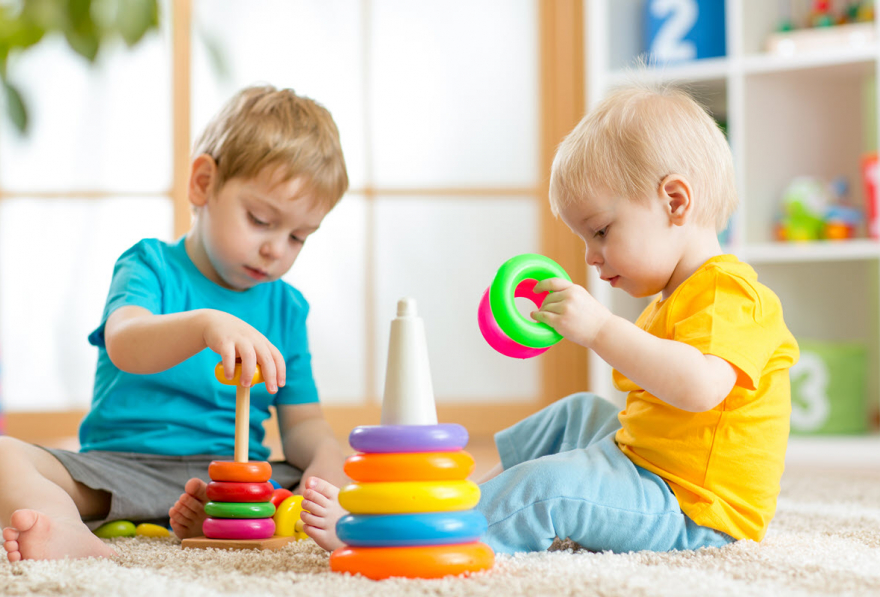Why is play important for children with Autism?
Play is a vital activity for all children. Not only is it fun, but it is also one of the most effective ways to learn new skills. Play helps build skills for thinking, language, problem solving, creativity, and emotional regulation. These are all areas that children with Autism may have difficulty with. Therefore, development of play skills is often a leading goal in therapy.
Speech pathologists frequently use play to help a child be interested in other people and activities. Engagement is particularly important for transferring skills to everyday environments.
What are the 6 stages of play?
While it may look simple, play is a complex skill and has many stages. Here are 6 stages to help you determine what stage your child’s development is at:
- Unoccupied play (birth to 3 months): A child makes movements to learn about their body.
- Solitary play (birth to 2 years): A child is not quite ready to play with others. They play alone and prefer to hold all the toys.
- Spectator/onlooker (2 years): A child begins to watch how other children play.
- Parallel play (2+ years): A child will play next to others. For example, they may drive a car on a mat together, however their play does not overlap.
- Associate play (3-4 years): A child will begin to interact with others during play. They may give things to others. There is interaction, however their activities are not yet organized and synced.
- Cooperative play (4+ years): Children will play together, and they have interest in cooperating with others to reach a shared play goal. Play is often organized and there may be group rules and roles.
My child plays differently to other children. How can I help?
Many children with Autism demonstrate play skills that are different to their peers. They may show uncommon interests or may have difficulty progressing past solitary play.
It is important to first think about how your child plays; they may line up items, maybe they like watching the wheels spin on a toy car, or perhaps they like to build a block tower and knock it down. Either way, your first step is to play just like them. This shows them you are a fun and safe play partner. For example, you might also spin the wheels on a different car next to your child. Find a play level that your child is comfortable with and follow their lead.
Once you have shown that you are a fun and safe play partner think about how you can slightly extend you child’s play. This might range from moving a bit closer to them, all the way up taking turns to push a car. Your speech pathologist can help guide you to find small ways to change play while keeping your child interested and happy.
Games and toys which require another person can quickly help your child to involve you in play. Examples include blowing bubbles, row-row-row-your-boat, rolling a ball, peekaboo/hide-and-seek, playing chase, and tickling.
If you are focusing on play with other children, consider peers with common interests and peers that are able to use similar communication skills. It may help to pre-train peers, so they understand your child’s way of communicating and play. During peer play provide support through showing or discussing with them how they can play together. Remember to keep this at a level appropriate to your child’s current abilities.
What about language learning in play?
Just like above, start by using sounds, words, or sentences at your child’s level. Once you have them feeling comfortable with your play language move up one small step. For example, if you are just making sounds with your child, add a single word like Go! If they are already using single words you can show them how to add one more, like “Go car!”
Children with Autism often seek routine and predictability. Therefore, keep your play language predictable. Each time you play a game start it the same way by using the same actions and words. Your child will know what to expect and will remember the steps from last time your played together.
Avoid repetitive questions, like “what’s this?” and “what do you want?”. Instead, focus on modelling language that will get results in a game. Examples include “push, pull, go, swing, more, again, crash, help, down, up”.
How can a speech pathologist help?
Speech pathologists are highly trained in play skills as this is the prerequisite of communication and enjoyment with others. A speech pathologist will assist you ton find the best strategies and programs to suit your child’s play, goals, and your lifestyle. They will help you choose your goals, find ways to incorporate these into your daily activities, provide advice for game/toy choices, and guide you up and down the levels of complexity.
All Harrison Speech Pathology therapists are experienced in building play skills in children with Autism.





